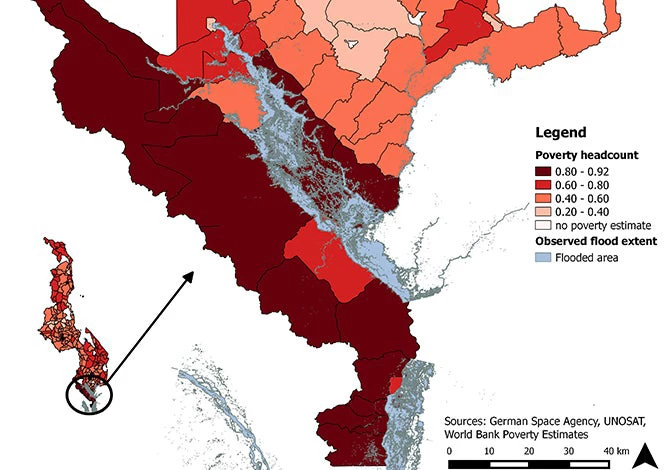
By Stéphane Hallegatte, Mook Bangalore, and Francis Samson Nkoka
Malawi is no stranger to significant flooding. In January 2012, floods affected more than 10,000 people and caused US$3 million worth of damage to households and infrastructure. But this year’s floods are much larger in magnitude, even unprecedented.
Beginning in early January, heavy rains triggered significant flooding in the southern and eastern districts of the country. The districts which experienced the largest impacts include Nsanje and Chikwawa in the south and Phalombe and Zomba in the east. So far, the flooding has affected more than 600,000 people, displaced over 170,000, and damaged agricultural crops covering more than 60,000 hectares.
While aggregate numbers and economic cost indicate the seriousness of the event, it is critical to look at exactly who is affected in the country. We have found that the poorest are on the front line.
Over-exposure of the poor
Overlaying the World Bank poverty map with satellite and spatial data on the flood inundation zones, the findings show that the regions most affected by the flood have per capita poverty rates of 75 percent or more (measured as US$1.25 per day. The average rate in Malawi is around 40 percent). These trends suggest that populations in flood-prone areas tend to be poorer. In the map above, blue represents flooding and areas in darker shades of red indicate higher poverty rates.
When the poor are affected by a flood or another natural hazard, they typically lose a larger fraction of their wealth and income. The result can keep them trapped in the cycle of poverty.
There are several reasons for this.
First, their homes are more likely to be completely destroyed. An assessment by GFDRR and RMSI (a global IT services company) has produced estimates of the mean damage ratio of residential structures to flooding in Malawi. For a flood depth of 0.50 m, 60 percent of the full value of a traditional house is lost, while the loss is 20 percent for a semi-permanent house (made with some type of cement or brick), and about 8 percent for a permanent house (usually made of all cement block with structural girding). Examining data from the most recent World Bank household survey for Malawi in 2013, across the country, 35 percent of households use traditional construction material for housing. However, in the four districts affected by the recent floods, this figure is significantly higher, at 47 percent.
Second, poorer households typically have less asset diversification, which means that their savings are more likely to be completely wiped out. For instance, being able to save with a formal financial institution allows for spatial diversification and reduces vulnerability. But only 22 percent of households in the affected districts have a bank account – the Malawi average is 30 percent.
Finally, poorer households participate in income generating activities that are more vulnerable to the effects of disasters and climate change, such as agriculture. In a household survey conducted last year, 60 percent nationwide responded that they worked on agricultural activities in the previous year, while 72 percent in the four districts affected did.
Beyond their exposure and their vulnerability, the poor may also have less ability to cope with the shock, given their lower incomes. In this regard, social protection can play a key role, but in Malawi, the rates of coverage are low. Using the World Bank’s ASPIRE database, the coverage of social protection in Malawi in 2010 was about 20 percent, for both poor and rich people. However, the average per capita transfer held was much lower for poorer quintiles (about US$0.01 per day) compared to richer quintiles (about US$0.18 per day).
In the absence of safety nets, frequent floods can serve as a barrier to asset accumulation and result in poorer households engaging in mal-adaptive strategies post disaster for example; by reducing food consumption to keep an asset base with potential impacts on health and child development. Put simply, a household may choose to consume less food or keep children out of school in order to compensate for assets lost in a flood.
Moving forward
This all entails a higher risk for the poor from disaster events which, quite frankly, is not a new finding nor is the impact in Malawi an isolated situation. But the finding helps to reinforce the importance of linking disaster responses with poverty reduction strategies. We see similar impacts on the poor in the Philippines following the recent Typhoon Hagupit in November 2013, Mumbai, Ethiopia and Honduras.
To help support the government’s flood response efforts in Malawi, the World Bank Group provided $600,000 from its Irrigation, Rural Livelihoods and Agricultural Development project for a quick response for land recovery, a damage assessment and to support the Government with response logistics. Additionally, the Bank continues to collect hazard, poverty and social protection data (accessible to the public) through online platforms known as Geonodes in addition to its data sites on ASPIRE, LSMS, and WDI. The case of Malawi shows how these different data sources can be quickly integrated to examine the distributional impacts of a disaster and help design more long-term responses.
In a context of a changing climate, disaster risks are likely to get worse, making resilience-building measures and policies even more important and urgent. In coordination with the Malawi Government, we are also examining the exposure and vulnerability of poorer households and individuals and reviewing instruments that can help them adapt and cope, such as social protection initiatives and safety nets, all of which can be rapidly scaled up after a natural disaster. Given the significant impacts of floods and other natural hazards on the poor as evidenced with the recent Malawi floods and the possibility that this can serve as a barrier to poverty reduction efforts in the context of changing climate conditions, in-depth data analysis linked to poverty reduction remains essential. The World Bank Group is working with experts around the world to help develop policy guidance and recommendations that can help.


Join the Conversation